M&S is turning its focus to food and out-of-town retail parks under its store renewal programme. It’s controversial, but the strategy seems to be working
The room is tense. The stakes are high. In a packed conference room at Westminster City Hall, Marks & Spencer is making its final stand as it battles for the future of its flagship Marble Arch store in London.
M&S is resolute. Its plans to bulldoze and rebuild the iconic 100-year-old building are necessary given the site is “dangerous”, “inefficient” and ultimately “unfit for the future”.
Yet its opponents are just as fierce, attacking M&S’s sustainability analysis and accusing it of “greenwashing claims on an epic scale”.
M&S doubles down. Unless the demolition is approved, the retailer vows to leave Oxford Street for good. It is a dramatic statement from one of the high street’s most emblematic institutions, which has been a primary shopping destination in the capital since opening in the 1930s.
But M&S is used to these sorts of battles. It is frequently hit with petitions and complaints from locals and protesters whenever it closes a store, as it looks to break free from its legacy estate and prioritise food over clothes. If greenlit, Marble Arch will be the highest-profile store in this ongoing – and controversial – renewal programme.
Though the multifloor megalith at Marble Arch is far larger than the typical M&S ‘renewal store’ – they are usually about the size of an Aldi, at 12,000 sq ft to 15,000 sq ft – the principle is the same.
While still containing small clothing & home selections, these stores have been revamped to make food the star of the show. In many cases, these branches are moving out of high street locations to more profitable out-of-town sites, while most of the clothing business migrates online.
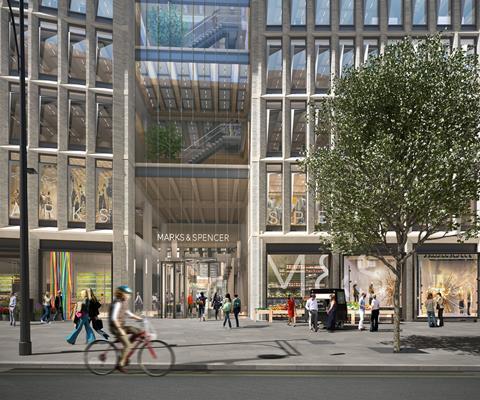
M&S is pursuing a “Snickers before knickers” operation, sums up Richard Curry, partner and lead food store advisor at Rapleys property consultants. “They do a very small amount of clothing such as socks, underwear, T-shirts, and maybe one or two household goods like candles, but most of it is food.”
The plans were originally developed by former M&S CEO Steve Rowe in 2019. In the face of profit slumps, Rowe planned to shut more than 100 full-line stores by 2028, to adapt to wider adoption of online shopping plus fierce competition from other retailers such as Next, Primark and Zara.
Under current CEO Stuart Machin, M&S is turbocharging that strategy. The retailer is accelerating 67 of those original store closures to 2025. However, the full-line store closures will be offset by the opening of 104 new Simply Food stores around the country.
In a video recorded at a newly-opened M&S store in Stevenage earlier this month, Machin tells attendees it’s about “growing a pipeline of bigger, better, fresher food stores.” And in many ways, he’s right. In the company’s latest first-half results, UK food sales were up 5.6% year on year to £3.32bn, and are now almost double the £1.75bn of revenue generated through its clothing & home divisions.
The store transformation is a crucial factor in this growth. Food sales in ‘renewal’ stores opened in the first six months of 2021 are up 17.8% this year against the same period the year before. That’s no flash in the pan: annualised sales are up an average of 10% across the 40 renewal stores opened since 2019.
According to Machin, these stores are also more profitable – due to the technology used to lower the cost of operations and getting quick payback on investment.
“It’s not like we’re leaving a town in one end of the country to open another at the other end”
This includes new self-service checkouts for clothing, digital click & collect, digital ordering in the café, and increased use of radio frequency identification (RFID) technology to track items through the supply chain, helping to reduce loss, improve stock accuracy and boost efficiency.
At two of the retail park stores opened last year – in Paisley and Solihull – the capital investment put into the transformation will be paid back in a little over two years.
That these two stores are in out-of-home locations is significant. The lowest-profitability M&S stores are typically located on high streets, where footfall has tumbled and it has struggled to cover a raft of high costs – including business rates, which are set to see a 10% increase next year. Machin recently called the rise “daylight robbery” and blamed it for fuelling the migration of M&S stores to city fringes.
“I’m committed to having great shops. While others go online, or go bust, we are investing heavily in stores,” he wrote in a passionate plea to chancellor Jeremy Hunt this month.
But “running a shop costs a lot more than running an online business, and a large part of that is down to business rates, which have zero link to profits or, indeed, reality. It’s why high streets and city centres are increasingly full of vacancies and dodgy shops.”
His desire for M&S to evolve with the times is also why the business is pushing so hard on its plans to make the Marble Arch store fit for the omnichannel future. “Our stores can’t sit in aspic. They can’t be museums to bygone days of retail,” he argued. “They must change in line with retail trends.”
PwC’s retail strategy director Kien Tan is an advocate of Machin’s strategy. “It’s just the way humans are changing and M&S is responding to that.”
Under Machin’s leadership, the grocer has been one of food’s biggest success stories in recent years, he says: “They’ve become a much more modern business and have realised their food has an amazing heritage to it, as well as great innovation. They just need to be where the people are.”
Knight Frank partner Richard Petyt also sees the acceleration of the new grocery-focused strategy as “the right step in the evolution of the business”.
Opinions weren’t always this positive, though – especially given the strategic shift was predicted to affect more than 8,000 jobs. Petyt recalls when M&S first announced store closures, “the general feeling amongst the public was ‘you can’t close a Marks & Spencer!’”
Tan maintains the backlash was unfounded. “All the other food retailers went to the edge of town and opened superstores 10, 20 years ago,” he notes, where people could drive and do a full weekly shop. “M&S should be able to do the same.”
Renegotiations
Much of M&S’s decision to accelerate its plans has been driven by timing. Historically, it has struggled to rotate its estate because of the complexity of its leases system and the unwillingness of high street landlords to renegotiate terms.
M&S is now taking advantage of the current macroeconomic landscape to get better deals. Earlier this year, operations and property director Sacha Berendji identified “opportunity in the market” as the likes of Debenhams and Next vacated spaces. Landlords have also become more willing to reduce rents and renegotiate terms in the aftermath of the pandemic.
Curry at Rapleys says this is especially true of high street locations owned by “institutional investors who only care about their income stream” and want to avoid vacant properties.
“Because the market is quite difficult at the moment and the scare factor of where inflation is going, [M&S] has probably got more of an angle with owners to be able to say ‘look you, you’ve got to help me out here because you’re not going to let it to anyone else’.”
M&S is “using the market economy to probably persuade owners to engage a bit more in that aspect”, Curry suggests.
The same advantage has applied when finding sites for new store openings. According to Machin, M&S has been able to “make the most of today’s market conditions, securing great space on strong terms with shorter leases”.
Even in cases where branches remain in the same location, there are advantages to the renewal programme. The new format requires less space, meaning M&S can lease the top levels to other businesses such as gyms, dental surgeries, or even accommodation. The strategy – one it is proposing in its Marble Arch store – is designed to make the estate more self-financing and avoid an exodus from the high street.
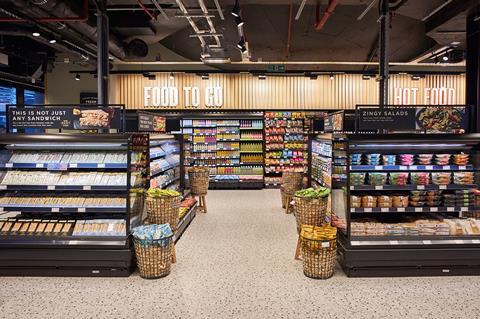
As a result, many national high streets still bear the M&S name. “We’re still in Liverpool, Birmingham, London, all these key city centres,” says Robbie Hynes, M&S communications director. “It’s more that we take it on a store by store basis. It really is individual.”
M&S is also reluctant to entirely leave smaller locations, partly because it knows its weight in the retail sector. As a key footfall driver in shopping destinations, the knock-on effect of closures on surrounding businesses and local communities can be immense.
“You go to some of the town centres where Marks & Spencer was a key anchor and a lot of them are in real difficulty now,” Petyt says.
One such case is Mell Square in Solihull, a once-thriving shopping precinct that turned into a “ghost town” after M&S left in June 2021, says Kris Miley, employee of The Merry Cobbler, a remaining store in the area.
And Welwyn Garden City’s main shopping centre The Howard Centre has suffered since M&S left in April. Photos taken by PwC’s Tan show just a handful of people strolling the shopping centre at what is typically peak time over lunch. “Heads up of what happens to a regional mall after M&S closes,” he says.
A solitary WH Smith tucked away at the far end is still operating, but it’s flanked by a raft of permanently shut shopfronts – including that of M&S. The old storefront signage is still there, but its doors are shut.
“It’s just the way humans are changing and M&S are responding to that”
However, in both Solihull and Welwyn Garden City, the store closures were followed by out-of-town openings only a short distance away.
Mell Square’s 55-year-old location gave way to the brand-new M&S Food Hall in the nearby Sears Retail Park, only a 1.8-mile drive south-west from the town centre. And Welwyn-based shoppers are now less than a 10-minute drive from its state-of-the-art location in the Roaring Meg Retail Park in Stevenage.
Hynes says this is a typical strategy for M&S. “It’s not like we’re leaving a town in one end of the country to open up another at the other end,” he stresses. “It’s more like even the smallest sort of changes can actually deliver a really good experience for our customers.”
M&S has not yet revealed where the axe will fall next year. One senior director tells The Grocer that’s because it doesn’t want to focus on the closings, but rather wants to celebrate the openings.
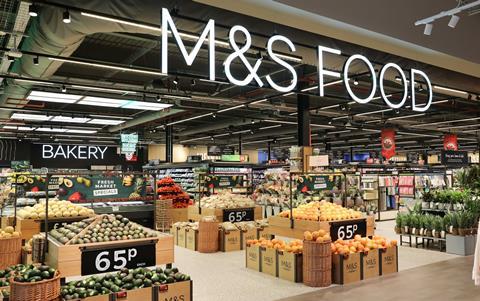
And a recent M&S store opening shows just what a celebration that can be. At the new Battersea Power Station store in London, a DJ spun joyful tunes while shoppers bobbed their heads and browsed the freshly-stocked aisles.
Brightly lit with colourful neon signs – a far cry from M&S’s classic look of old – the branch featured walls lined with a swathe of aesthetically pleasing Christmas goodies, two front-of-store displays of Colin the Caterpillar and Percy Pig-themed products, plus a fruit & veg section that swarmed with the biggest crowds of all.
The store also has a bakery and to-go coffee areas for commuters in a rush, as well as sushi and hot food for those popping by to grab lunch. There is an entire vegan chilled food aisle – not merely a shelf – and a digital, self-service clothing & home collection desk, where shoppers can easily collect and return the items they buy online.
The buzz among shoppers suggests M&S may well have found the “fit for the future” customer experience it so often talks about – one that will likely be welcomed at the site of its 104 planned Simply Food openings.
When it comes to closures and modifications, however, its Marble Arch store only serves to illustrate the antagonism it will face.







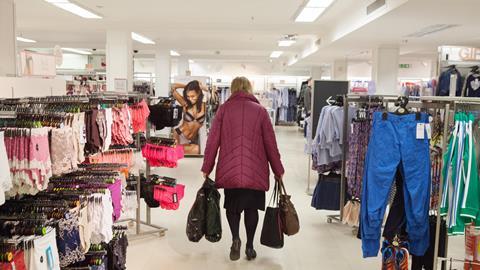



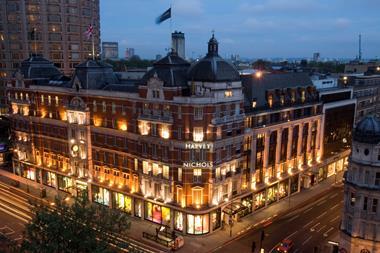

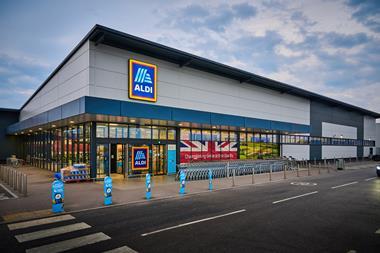






No comments yet